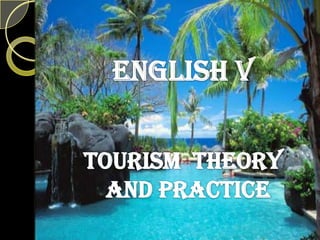
Tourism1
- 1. ENGLISH V TOURISM THEORY AND PRACTICE
- 2. PEDAGOGICAL AND TECHNOLOGICAL UNIVERSITY OF COLOMBIA BY: DIANA L. CARDENAS SANTOS
- 3. INTRODUCTION WHAT IS TOURISM??? THE AMORPHOUS NATURE OF TOURISM HAS MADE IT DIFFICULT TO STRUCTUREITS «DEFINITION» ACADEMIC WRITERS GIVE THEIR OWN AS FOLLOWS
- 4. THE TOURISM LIKE A ECONOMY ACTIVITY Tourism has become a popular global leisure activity. In 2008, there were over 922 million international tourist arrivals, with a growth of 1.9% as compared to 2007. International tourism receipts grew to US$944 billion (euro 642 billion) in 2008, corresponding to an increase in real terms of 1.8%.
- 5. DEFINITION OF TOURISM Tourism is a collection of activities, services and industries that delivers a travel experience, including transportation, accommodations, eating and drinking establishments, retail shops, entertainment businesses, activity facilities and other hospitality services provided for individuals or groups traveling away from home.
- 6. The World Tourism Organization (WTO) claims that tourism is currently the world’s largest industry with annual revenues of over $3 trillion dollars. Tourism provides over six million jobs in the United States, making it the country's largest employer.
- 7. Mathieson and Wall. Thetemporalymovement of peopletodestinationsoutsidetheir normal places of work and residence, theactivitiesundertakenduringtheirstay in thosedestinations, and thefacilitiescreatedtocatertotheirneeds.
- 8. Macintosh and Goeldner. Thesum of thephenomena and relationshipsarrisingfromtheinteraction of tourists, businesssuppliers, host goverments and host comunities in theprocess of atracting and hostingthesetourists and othervisitors.
- 9. SUPPLY AND DEMAND Istherelationshipbetweenthequantitythatproducerswishtosell at variousprices and thequantity of a commoditythatconsumerswishtobuy. Demanddependsontheprice of thecommodity, theprices of relatedcommodities and consumersincomes and tastes.
- 10. Terms of interest Excursionist: Persons traveling for pleasure in a period less than 24 hours (MForeignTouristacintoshand Goeldner, 1986). : Any person visiting a country, other than that in which he/she usually resides, for a period of at least 24 hours (Committee of Statistical Experts of the League of Nations, 1937).
- 11. Travel: The act of moving outside one's home community for business or pleasure but not for commuting or traveling to or from school (Macintosh and Goeldner, 1986). Visitor: Any person visiting a country other than that in which he/she has his/her usual place of residence, for any reason other than following an occupation remunerated from within the country visited (United Nations Conference on International Travel and Tourism, 1963).
- 12. Dimensions of TourismAll tourism activities are related to one or more of the following dimensions of tourism. Attractions: Are the primary motivation for traveling. They may be a primary destination such as Disney World or secondary destination which are interesting places to visit on the way to your primary destination. Attractions usually focus on natural resources, culture, ethnicity or entertainment.
- 13. Culture: A way of life which is observed through a peoples religion, history, government and traditions. Ethnicity: To visit family and friends
- 14. Natural Resources: Natural resources are the combination of physical features, the climate , and the natural beauty of the area. The challenge to managing natural resources based tourism is to preserve the natural resource from the impact of the tourist's.
- 15. X-treme Tourism: Tourism based on high adventure activities Facilities: When tourists arrive at attractions they require facilities to provide services. Food & Beverage: Not only provide basic sustenance for tourists but an important factor in the overall tourism experience.
- 16. Infrastructure: The basic services on which all tourism depends. These systems include water and sewer systems, communication networks, medical facilities, electricity, police and fire protection and roads
- 17. Hospitality: The community's attitude which permeates every tourism location that makes the tourist feel welcome and safe. It is the result of the interaction between the tourist and the local population.
- 18. TRANSPORT Time and Money: This is the critical component to tourism, the ability to get from Point A to Point B and back, or to Point C, D, E.... The variables of Time, how long it takes to get to a specific destination, and Money, how much it costs to get to your destination. Tourism developments are dependent on the ease of access and types of transportation available.
- 19. EssentialRequirements for Tourism Time: as the hours for leisure increase so does the opportunity for travel. Changes in work days or hours, school calendars will affect how and when people can travel. The overall travel pattern has moved from a two week vacation to 6-8 three or four day mini-vacations per year.
- 20. Money: the majority of travel requires discretionary income. Discretionary income is money left over after all monetary obligations (food, rent and taxes) have been paid
- 21. Mobility : is the access to transportation (car, bus, plane, train or ship) and the hours required to get to their destination.
- 22. Motivation: is the reason people travel. Motivations may include seeking novelty, education, meet new people, adventure or stress reduction.
- 23. THANK YOU